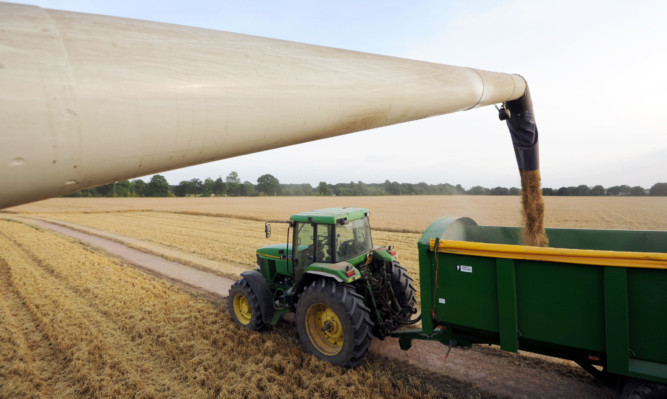The 2014 Scottish harvest had that “feelgood factor” about it all the way through in terms of yield if not price.
The latest statistics from the Scottish Government back up the optimism as to the size of the crop, with the final estimate confirming the 3.2 million tonne harvest as the biggest for 20 years.
This represents an increase of 384,000 tonnes on 2013 and marks another step in the recovery from the very poor 2012 crop when yields were affected by poor growing conditions and a prolonged wet harvest.
Scotland’s chief statistician released the latest estimates of the Scottish cereal and oilseed rape harvest which show that the latest increase is due to an estimated 13% improvement in overall cereal yields over the last year.
Overall yields are estimated at an average of 7 tonnes per hectare (t/ha) ranging from 6.1 tonnes per hectare for spring barley and oats, to 9.1 tonnes per hectare for wheat. Average oilseed rape yields are estimated at 4 tonnes per hectare. The total area of land sown has risen by 4,000 hectares.
The accompanying statement says;
“This has been a good year for cropping despite occasionally difficult conditions; harvesting began early and progressed quickly, with more consistency in yields across the country. There is some disparity between the north and south of the country, after remnants of Hurricane Bertha hit the north.
“The longer term trend of improving yields continues, with the average cereal yield for the last 10 years 7% higher than in the previous decade.”
This last figure goes slightly against the common feeling that yields ares stuck on a plateau and may even have decreased as the range of plant protection products becomes increasingly limited. The chief statistician makes his or her estimates using the results of the June census to assess the area sown to each crop. These are multiplied by yield estimates made by farming, trade and advisory sources to give total yield.
These final estimates are 62,000 tonnes or 2% lower than initial estimates made in October. Increases in spring barley and oilseed rape production have been revised down. Increases in winter barley and wheat have been revised up and a greater decrease in oat production is now being estimated.
Wheat and winter barley have seen the largest estimated rises in production, increasing by around 52% and 46% respectively.
Around 990,000 tonnes of wheat, up from 650,000 tonnes, and around 400,000 tonnes of winter barley, up from 280,000, are expected.
Spring barley production is stable at around 1.7 million tonnes, despite a fall in grown areas. Oats are the only major cereal crop to see considerably reduced production; down 18% from 190,000 to 150,000 tonnes, following an 80% increase in 2013 when oats replaced wheat and oilseed rape crops in part of the country.
The figures were produced in accordance with professional standards set out in the Code of Practice for Official Statistics.
farming@thecourier.co.uk
